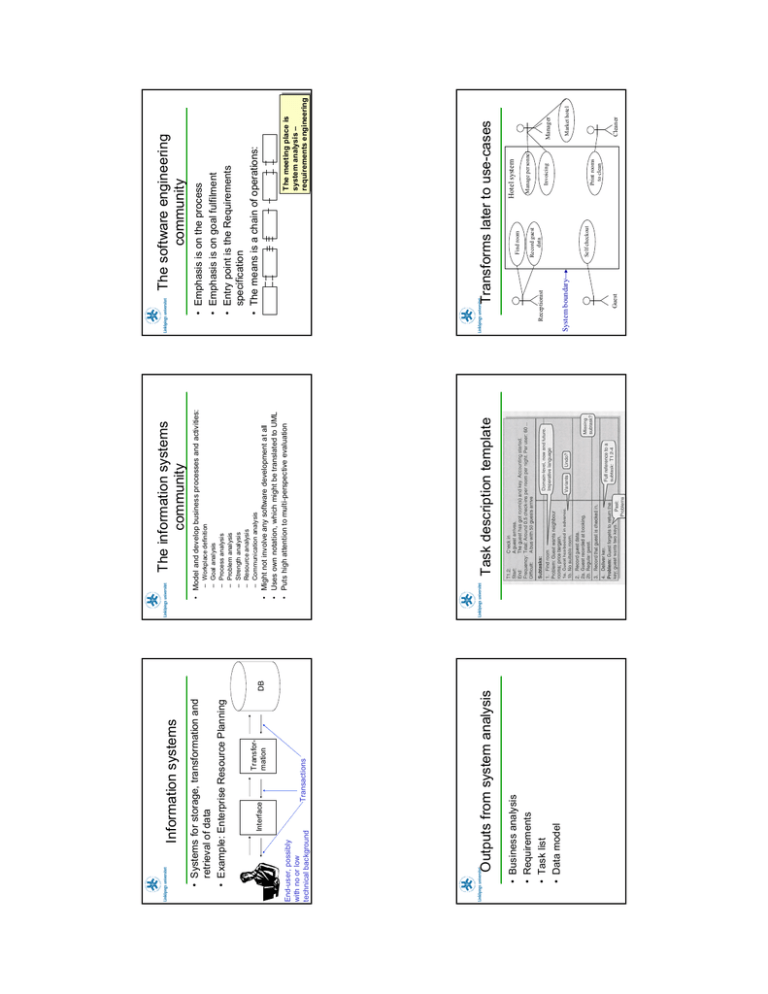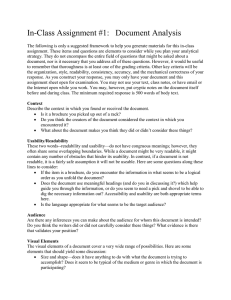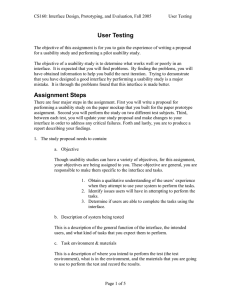s m te y
advertisement

• • • • Transactions Transformation DB Business analysis Requirements Task list Data model Outputs from system analysis End-user, possibly with no or low technical background Interface • Systems for storage, transformation and retrieval of data • Example: Enterprise Resource Planning Information systems Workplace definition Goal analysis Process analysis Problem analysis Strength analysis Resource analysis Communication analysis Task description template • Might not involve any software development at all • Uses own notation, which might be translated to UML • Puts high attention to multi-perspective evaluation – – – – – – – • Model and develop business processes and activities: The information systems community Guest System boundary Receptionist Self checkout Record guest data Find room Print rooms to clean Invoicing Manage personnel Hotel system Cleaner Market hotel Manager Transforms later to use-cases The Themeeting meetingplace placeis is system systemanalysis analysis–– requirements requirementsengineering engineering • Emphasis is on the process • Emphasis is on goal fulfilment • Entry point is the Requirements specification • The means is a chain of operations: The software engineering community • • • • • • Subject Course code Max-enrolment Enrolled-in Name Personal number Curriculum Think-aloud test Normal users Observation test Automatic logging Heuristic evaluation 50% hit rate User review with expert users Avoid trade-union representatives and ITexperts Usability testing Course Student Data model: ER-diagram • • • • • • • • • Input: artefact, test tasks (realistic, closed) Participants: test user, facilitator, log keeper Explain purpose Background and daily matters Task Observe If necessary: give hints Debriefing Output: List of problems Testing process Different formats • • • • • Missing function Task failure Annoying Medium problem Minor problem Usability problem severity classes – Task analysis – Prototyping (HI-FI, LO-FI), 3 rounds? • Relevance • Efficiency • Attitude • Learnability Usability engineering: Usability • Originally a political view of system development • The users shall have the power of system development • The maintenance and development of user professional skill is emphasized • Engineers shall implement prototypes and give alternatives • Light-version: Participatory design The Scandinavian approach From Carlshamre (2001) A Usability Perspective on Requirements Engineering Doctoral dissertation, Linköping University, Sweden. Usability metrics Can go really wrong! Creative and fun. Can be used for other purposes too. Increase comprehension, reduce learing period. Often used in graphical user interface (GUI) design. • Embrace change Lundsten Lundsten&&Holst HolstLiTH-IDA-Ex-03/068-SE LiTH-IDA-Ex-03/068-SE – The user is presented with information of all phones connected – The user changes parameters for a phone – The user activates a dialup connection – The user inactivates a dialup connection • The customer is always available • The customer writes user stories, ex: User stories in eXtreme Programming Metaphors • Make frequent small releases • Lundsten and Holst: one release per week in two major iterations • Create spike solutions to gain more confidence in planning • Never add functions early Prototyping in eXtreme Programming • Refactor mercilessly to keep the design simple. • Refactor whenever and wherever possible. • Lundsten & Holst: refactoring for each user story gave confidence to change the system • Architecture evolves: 4 major changes, ex: new layer to manage multi-threading • One approach to avoid the maintainability problem Refactoring in eXtreme Programming • Can you translate the action diagram and the problem diagram into UML? • Reflections? Home assignment





